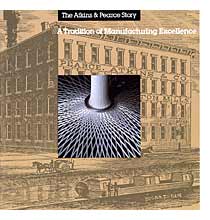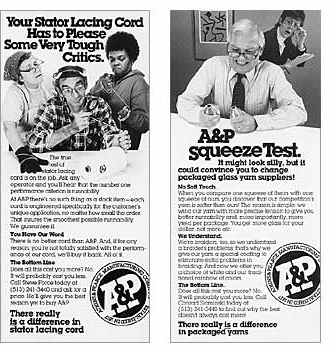


![]()
The Atkins & Pearce Manufacturing Company is an industrial braider in
Cincinnati, producing braided sleeving for electrical cords, braided candle
wicking, stator lacing cord for electrical motors, decorative trim for caskets
and bowling bags and metallic braid for decorative packaging. They also package
glass yarn for other braiders.
The
Problem
At the time they approached us about energizing their marketing program in
1985, annual sales had been flat for a decade, at about $10 million. The company
was 200 years old, located in old factory buildings in downtown Cincinnati.
Since there had been no essential change in braiding technology during that
time, the company operated with thousands of braiding machines more than 100
years old. There were many positives about the company, however. Management
was lean and efficient and production was mostly automated, allowing them
to be the low cost producer in each of their markets. Their quality was superior,
and they were well regarded where they were known. They were also cash-rich.
 The
Solution
The
Solution
During our first meeting in their offices, we made several suggestions for
improving sales techniques. The next month, even before we returned with a
marketing plan, sales increased by more than 10%.
We soon discovered that virtually all their existing markets were classically
mature, with one in immediate danger of collapsing due to new technology and
one unprofitable due to intense competition and low margins. We identified
threats and opportunities in each market segment and for the corporation and
made several specific recommendations: 
1) In the packaged glass yarn segment, we determined that their opportunities
lay in developing white yarn accounts (as opposed to the primarily colored
yarns which they sold at that point).
2) In the candle wicking segment, threatened by inexpensive Chinese imports,
we recommended they focus on capturing projected growth among current customers
in the domestic market.
3)
In their largest segment, sleeving, we recommended they try to achieve strong
market dominance by encouraging potential customers to eliminate their in-house
capacity. This was done by buying that capacity or producing sleeving at a
lower cost. 4) In the extremely mature stator lacing cord segment, which was threatened
by new technology, we suggested identifying export opportunities and protecting
their domestic position by acquiring capacity in the new technology.
5) In the high-profit decorative trim segments, the company lacked market
information on opportunities. We recommended additional research before deciding
on a marketing direction.
 In addition, we concurred with the company's desire to enter the advanced
composites market, where their low-cost production techniques could bring
economy to high-tech processes, and much of our effort over the next five
years was directed toward this end.
In addition, we concurred with the company's desire to enter the advanced
composites market, where their low-cost production techniques could bring
economy to high-tech processes, and much of our effort over the next five
years was directed toward this end.
Other
issues we presented were the need for competitive market data and knowledge
of customers' markets and technologies; the need for a more aggressive selling
posture, including a systematic sales call program; and the need to become
involved in industry supplier networks.
In all segments, awareness of the company was surprisingly low, and we recommended
increasing promotion. In fact, the company had produced only one item, a sample
card of metallic braid, in its entire 200 year history. The subsequent success
of the increased promotion was fueled to a great extent by superior product
quality and the company's low cost of production. A comprehensive marketing
plan was prepared, and, to the credit of the company, implemented. The plan
included specific promotional tools and activities and a line item budget.
Among the promotional items produced:
New corporate identity
Corporate capability brochure
Trade media advertising in selected segments
Trade show booths
Product literature
The Result
After the first year of increased marketing activity, sales had doubled. Sales
doubled again by the fourth year. By the fifth year, Atkins & Pearce had
built and moved into their own industrial park, a much larger facility in
Covington, Kentucky. The company also successfully penetrated the advanced
composites market, where margins were significantly higher than their traditional
mature markets. Their new end products included braided light poles and braided parts for the automotive and aerospace industries, and they were working with engineers at Drexel University to braid an entire car body.